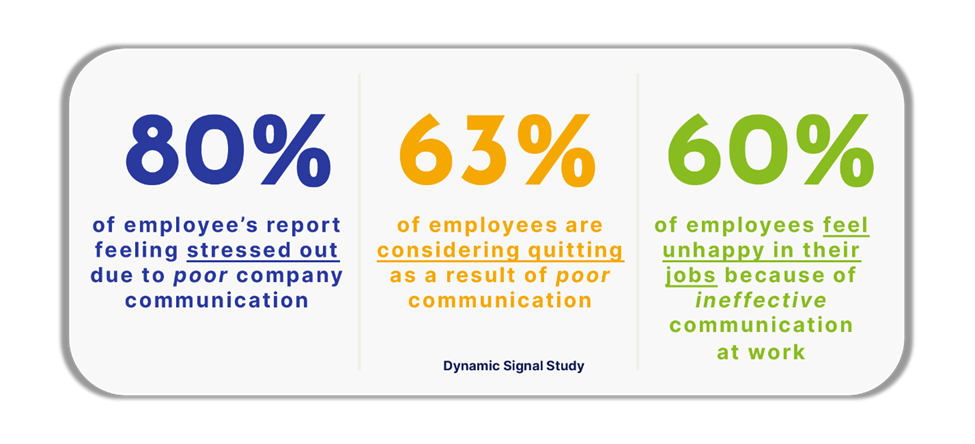Everyone Benefits from Year-Round Communications
September 25, 2023
Beatriz Lucki
Communication is at the center of the human experience. Communicating effectively strengthens everything: our relationships, company culture, employee engagement, and, yes, even your benefits strategy. Studies reveal that 50% of the challenges facing organizations stem from shortcomings in their communication of benefits.
In our current workplace environment, retaining employees can be challenging. However, transparent and authentic communication with employees can go a long way in addressing this issue. The time for a better understanding of the communications landscape is now.
Why Should Year-Round Communications Matter to You
Communication throughout the year fosters transparency, provides opportunities for education and alignment, and helps promote a sense of belonging for employees. It also helps address concerns, build trust, and maintain a positive work culture.
One-third of U.S. adults report not fully understanding their health benefits. Additionally, 66% of employees wish they were more informed about their benefits throughout the year to get better value from them. Creating a strategic benefit communications plan makes good business sense and can positively impact the employee experience. This impact includes an engaged culture, healthier employees, cost savings, value in recruiting and retaining employees, and better utilization of benefit dollars.
A study by The Economist Intelligence Unit further illustrates how poor workplace communication can hurt the success of a workplace — it may result in:
- Failure to complete projects — in 44% of the cases
- Low employee morale — in 31% of the cases
- Missed performance goals — in 25% of the cases
- Lost sales — in 18% of the cases
What Should You Communicate
Communication is essential on several levels, ranging from groundbreaking company information to day-to-day interaction.
Significant news: This includes layoffs, mergers and acquisitions, management changes, new product announcements, bankruptcy, organizational crises, and company reorganization. It is essential to inform employees of such news promptly, truthfully, and transparently. Nothing hurts employee morale and loyalty more than hearing about something on the morning news rather than from their employer.
Quarterly and yearly goals, initiatives, and achievements: Give employees access to company sales data, upcoming and ongoing goals or initiatives, and details on the company’s future direction. They want to know that they are working for a healthy, financially solvent company and will likely be interested in the direction decision-makers are taking the company.
One-on-one meetings: All employees should have the opportunity to meet with their immediate supervisor periodically to discuss expectations, current projects, and concerns or questions on either end. This meeting should be separate from any performance evaluations to foster maximum openness.
Praise and recognition: Employees want their hard work recognized, so make sure your management team finds ways to praise significant accomplishments of teams or individuals. Whether it’s a personal email, an in-person handshake, or an announcement on the company intranet, don’t let employee achievements go unnoticed.
New hires and promotions: Keep employees in the loop by announcing new hires and promotions to the company or branch. This will help new employees feel welcome and further the recognition of promoted individuals.
Ongoing company news or information: This could be anything from educating employees on their benefits to how current projects are progressing to updates in company policy. Through your chosen communication channels, make sure employees are always notified of any information relevant to them. The more involved they are with the company, the more loyalty they will likely have.
85% of Employees Are Most Motivated When
Internal Communications Are Effective!
How Should You Communicate
Eliminating communication barriers enables employers to connect with a diverse, multi-generational workforce. Employers should ask themselves: What do we want to tell our workforce, and what do they want to know?
Consider the following process to determine the how:

Assess your current state
In order to develop your communications plan, you need to look in the mirror and determine where you currently are. There are several things to consider: your audience demographics (gender, educational level, age, learning style, job type), how often you communicate, what channels you use to communicate, and what challenges you currently face. Demographics play a key role in determining your strategic communications roadmap.
Develop a strategic communication plan
Based on the assessment outcomes, your internal communication plan should define your goals and objectives, establish priorities, keep everyone in the company updated, and define your company culture. These questions should be answered:
- What are you trying to accomplish?
- Who is your audience?
- What’s the message you want to send?
- What channels and tactics are you going to use?
- What testing are you going to do?
- How will you measure success, and what does it look like?
Implement the plan
Communicate with employees so they know what to expect. Creating an annual calendar is an excellent tool to ensure employee engagement. Use internal influencers to promote the plan, engage their network, and carry out a genuine cultural shift.
Review, evaluate, and refine
A communication plan is more than just a one-and-done initiative. It requires quarterly or semi-annual review, evaluation, and refinement. Let’s take employee benefits as an example. Open enrollment is an excellent time to educate your employees about their benefits, but it should not be the only time employees hear about them. Keep your benefits top of mind by mapping an entire year of communication centered on the value of your employee offerings. Focus on one or two products or features every month, then monitor your plan’s performance quarterly to tweak as necessary and improve communication accordingly.
Year-round communication strengthens everything! It is at the core of the workplace. So, master the concept and don’t miss the opportunity to connect.
“The single biggest problem in communication is the illusion that it has taken place.”
George Bernard Shaw




.png?width=840&height=473&name=Vimeo%2c%20%E2%80%9C2021%20Communications%20statistics%20in%20the%20workplace%2c%E2%80%9D%20(1).png)